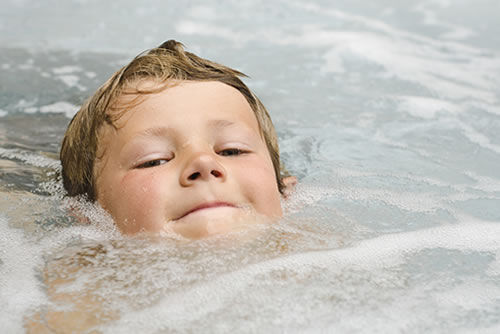
Eliminate harmful hot tub bacteria through preventative measures and by implementing your regular spa maintenance protocol.
- Drain and replenish the hot tub with fresh water
- Disinfect all surfaces, filters, chemical feeders, and plumbing
- Wipe the inside spa cover thoroughly
- Add bromine or chlorine, using test strips to balance the chemicals and adjust the PH and alkalinity levels
Should I be worried about hot tub bacteria?
When neglected, a hot tub becomes a petri dish, wherein microbes multiply ferociously. Consequently, the spa becomes contaminated and unsafe to use. Sometimes microbes produce odours or biofilm—grime floating on the surface or lining the plumbing. At other times, they are harder to detect.
Microbes find the warmth and moisture of a spa attractive. But we must repel them any way we can for our own health and hygiene. When bathing, our pores open wider than usual, leaving our bodies susceptible to infection.
A Warning on Hot Tub Folliculitis
Commonly, an untreated hot tub produces a rash similar that an old wet bathing suit leaves. The condition, hot tub folliculitis, characterized by inflamed hair particles, arises in two ways:
- The hot tub exceeds its normal capacity and the sanitizer dissipates;
- The hot tub maintains inadequate chemical levels, allowing bacteria to thrive.
The longer microbes live and breed, the higher the risk of infection. For this reason, we must learn to detect and treat unsanitized water.
How to test water for bacteria at home
Hot tub manufacturers make testing chemical levels easy. You can buy strips that identify imbalances and suggest remedies. Interestingly, such strips are not always necessary. If you sniff the water, you can smell sourness when microbes are at work. Of course, we can’t always rely on our noses as an effective measure against bacteria!
6 ways to prevent bacteria from developing in your spa
- Encourage all bathers to shower before use.
- Always avoid bathing with open wounds.
- Keep pumps running.
- Maintain clean filters.
- Change the water on a regular basis.
- Clean your hot tub periodically.
Frequently Asked Questions
Can you get a bacterial infection from a hot tub?
Yes. Due to the fact that your pores are open larger than normal, it leaves your body more susceptible to infections. This is why hot tub manufactures and retailers outline detailed instructions on how to maintain your tub. Proper care, cleanliness and maintenance in balancing the chemicals, you can prevent bacterial infections.
Does chlorine kill hot tub folliculitis?
Hot tub folliculitis is a condition that occurs from an infection in the skin from a bacteria called Pseudomonas aeruginosa. Chlorine kills the bacteria, so it is a way of preventing the infection, however, it is not used as a cure for the infection.
How do you get rid of hot tub folliculitis?
According to Healthline, the following can alleviate symptoms and eliminate folliculitis:
- Use apple cider vinegar on a cloth and apply it to the affected area. Bathing in a mixture of water and apple cider vinegar is also an effective remedy
- Use an antibacterial ointment such as Neosporin to prevent any further infections
- Polysporin or any anti-itch creams will reduce the symptoms
- In addition, use warm compresses to alleviate the itchiness and speed the time it takes to heal the area




